Abstract
This study investigates the application of foam asphalt (FA) to enhance the compaction effectiveness of a hot in-place recycling asphalt mixture (HIR-AM) during the HIR process of old road surfaces. Initially, the process parameters for FA preparation were determined through expansion-rate and half-life tests. Subsequently, the study focused on evaluating the impact of FA on the compaction quality of HIR-AM. Performance assessments were conducted through rutting tests, low-temperature bending tests, Hamburg wheel tracking tests, dynamic modulus analyses, and various other experiments to evaluate the road performance of HIR-FAM. Finally, the research findings were validated through practical engineering applications, and the construction process for HIR-FAM was summarized. The research results reveal that the optimal foaming temperature for SBS asphalt is 170 °C, with an ideal water content of 1.7%. Under the same compaction temperature, HIR-FAM demonstrated a significant reduction in void content, ranging from 3.8% to 21.2% compared to HIR-AM. Moreover, a higher proportion of FA usage resulted in a more substantial decrease in void content. Compared to HIR-AM, HIR-FAM exhibited notable improvements, including an 11.6% increase in dynamic stability, a 13.4% enhancement in bending strength, a 13.3% increase in maximum bending strain, an 8.1% improvement in residual stability, and an 8.5% boost in freeze–thaw splitting strength. Furthermore, HIR-FAM demonstrated superior water-thermal stability and resistance to low-frequency loads. Paving a test road verified that the adoption of foam asphalt in thermal recycling led to a compaction density increase of over 0.79% compared to traditional in situ thermal recycling sections, with improved compaction uniformity.
1. Introduction
In the field of transportation in China, the total carbon emissions are enormous, accounting for approximately 10% of the national terminal carbon emissions [1]. It is one of the key areas of concern for carbon emissions control. With the comprehensive implementation of China’s “dual carbon” strategy, the pressure to reduce emissions in the transportation industry will increase further [2,3]. Achieving carbon reduction in the transportation industry under the backdrop of carbon neutrality is an important research topic [4,5,6,7]. Hot in-place recycling (HIR) can fully utilize reclaimed asphalt pavement (RAP), which has the characteristics of low maintenance cost, short construction period, low traffic disturbance, etc., and can effectively reduce carbon emissions [8,9,10,11,12]. In recent years, it has been widely applied in the road maintenance industry [13,14].
Due to the low mixing temperature and the presence of a significant amount of aged asphalt in the on-site hot recycled asphalt mixture, the efficiency of mixing is reduced [15]. This leads to insufficient compaction of the recycled road surface and poor-quality information, making it prone to early deterioration [16,17]. Warm-mix asphalt (WMA) technology can reduce the viscosity of asphalt binder without increasing the heating temperature [18], thereby improving the workability of the mixture and effectively enhancing the compaction quality of asphalt pavements [19,20,21]. Techniques like foam warm-mix asphalt (FWMA) utilize the high temperature of asphalt to vaporize liquid water, leading to foaming of the asphalt and an increase in its surface area. This indirectly improves asphalt flowability, achieving an anti-sticking effect [22,23]. FWMA is known for its simplicity of operation and lower cost, making it one of the most prominent warm-mix technologies [24,25].
However, this technique also has some drawbacks. A compaction temperature that is too low can result in inadequate adhesion between the binder and aggregates, leading to a softer mixture with poor resistance to deformation [26]. Moreover, the injection of water during the foaming process can make foam warm-mix asphalt mixtures more susceptible to moisture damage [27]. Combining the characteristics of PAP and FWMA technologies can effectively address the aforementioned issues [28]. For instance, due to material aging in RAP, it exhibits better resistance to rutting [29]. Meanwhile, FWMA technology can improve the poor workability of RAP by reducing the viscosity of aged asphalt binders. Additionally, the addition of PAP offers more high-viscosity binders, enhancing the adhesion of the mixture and thereby compensating for the shortcomings in FWMA performance [30]. Research by A. Rondón-Quintana [31], Zheng, Z. G. [32], and others has shown that FWMA has been effective when applied in plant-mixed hot recycling mixtures. P. Abreu [33] and others investigated the impact of RAP dosage on the performance of different foam asphalt recycled mixtures and found that the same RAP dosage of foam asphalt can reduce the recycled mixtures compaction temperature by 15~30 °C. Furthermore, foam asphalt recycled mixtures with high RAP content still exhibit good water stability. Zhao, S. [34] and Ashiqur, R. M. [35] conducted a series of indoor experiments on warm-mix recycled mixtures. They found that compared to hot-mix asphalt (HMA), due to the lower mixing temperature of FWMA, it is more prone to rutting and moisture damage. However, increasing the RAP content has a positive impact on the resistance to the rutting, water stability, and fatigue performance of WMA. The different preparation methods of foam asphalt recycled mixtures and the addition of rejuvenators can also impact the performance of the mixture: Kavussi, A. [36] compared the rutting performance of FWMA-A (all binders used were foam asphalt) and FWMA-B (hard asphalt was foam asphalt). The results showed that when the compaction temperature was 115 °C, the rutting depth of FWMA-B was reduced by 0.3 mm compared to that of FWMA-A after 20,000 cycles. Jeong, M. M. [37] and others analyzed the effect of a rejuvenator on foam asphalt mixtures containing 100% RAP. They found that adding a 6% rejuvenator improves its resistance to cracking but significantly decreases its structural integrity. Consequently, much research has been conducted by scholars to reduce the compaction temperature of recycled mixes, increase the proportion of RAP blending, and the synergistic effect of FWMA and RAP, but there is limited research on the application of FWAM technology in HIR to improve the compaction quality.
This study was conducted in the context of the S511 road improvement and expansion project in Wudi County, Shandong Province. Foam warm-mix technology was applied to HIR, achieving 100% utilization of RAP, and a systematic investigation into the impact of FA on the compaction quality of HIR-AM was carried out. Firstly, the FA foaming process was determined based on foaming efficiency. Subsequently, by studying the compaction quality of three types of HIR-FAM, the preparation process of HIR-FAM was established. The experimental verification of their road performance was conducted. Finally, in conjunction with field engineering, the research findings were validated, and a set of construction processes for HIR-FAM was proposed, providing a reference for the promotion and application of this technology in asphalt pavement maintenance projects.
2. Materials and Methods
2.1. Project Description
The project is located in the vicinity of S511, Jieshishan Town, Wudi County, Shandong Province, as shown in Figure 1a. The original road surface’s upper-layer structure is 4 cm AC-13, with an average daily traffic volume (ADT) of 45,799, making it a heavily traveled main road. Wudi County experiences average low and high temperatures of −16.5 °C and 39.4 °C, respectively. Prolonged temperature variations and repeated heavy traffic loads have led to severe fatigue cracking and rutting in the asphalt pavement, as illustrated in Figure 1b. According to the Standard JTG 5210-2018 [38,39], the pavement condition index (PCI) for this road segment was assessed, resulting in a PCI of 73.07, indicating the need for pavement maintenance. The total construction length of the project is 9.8 km, and it is built to the standards of a first-class highway. Approximately 61% of the road sections underwent maintenance using HIR, as shown in Figure 1c.
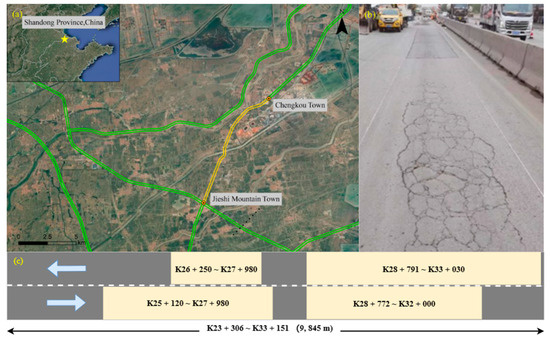
Figure 1.
Project overview, (a) project location, (b) original road condition, (c) sections utilizing HIR.
2.2. Materials
SBS asphalt was used as the new asphalt, and limestone served as the coarse aggregate for the new asphalt mixture. Testing and analysis of the new asphalt and recycled asphalt from RAP were conducted following Test Procedures JTG E20-2011 [40,41,42,43,44], with the test results presented in Table 1, which shows that the recycled asphalt is hardened due to the aging effect of the asphalt, and its performance no longer meets the corresponding technical requirements of the Construction Technical Specifications (JTG F40-2004) [41,42,43]. The physical properties of the aggregates are listed in Table 2, and it is found that the recycled aggregates are good in terms of crushing value, abrasion loss, and density, which can ensure that the in situ hot recycled asphalt mixtures can play the role of the skeleton support and contribute a certain degree of strength to the recycled asphalt mixtures. Recycling agents are added to restore the original properties of recycled asphalt, and their technical properties are presented in Table 3.

Table 1.
Technique performance of asphalt.

Table 2.
Test results of mineral aggregates.

Table 3.
Performance parameters of the recycling agent.
2.3. Proportioning Design
Based on the performance indicators and sieve analysis results of RAP and new aggregates, the gradation design for the AC-13 mixture was conducted. Considering an on-site milling depth of 4 cm and based on engineering experience, the addition of new asphalt mixture to the recycled mixture is set at 15%, and the gradation design of the recycled mixture is shown in Table 4. According to the specifications [41,42,43,44,45], the optimal asphalt content for the hot in-place recycle asphalt mixture was determined to be 5.1%, the additional asphalt content was 0.64%, and the asphalt content for the new asphalt was 4.3%.

Table 4.
Mineral aggregate gradation.
2.4. Experiment Design
This research workflow is shown in Figure 2, which mainly includes determining the foam asphalt foaming process using the expansion rate and half life; the mensuration of the compaction characteristics of different HIR-FAM; the evaluation of the road performance of HIR-FAM using the rutting test, low-temperature bending test, Hamburger rutting test, and the dynamic modulus test; and finally, the verification of the results of the indoor study through the paving of a test road in a real project.
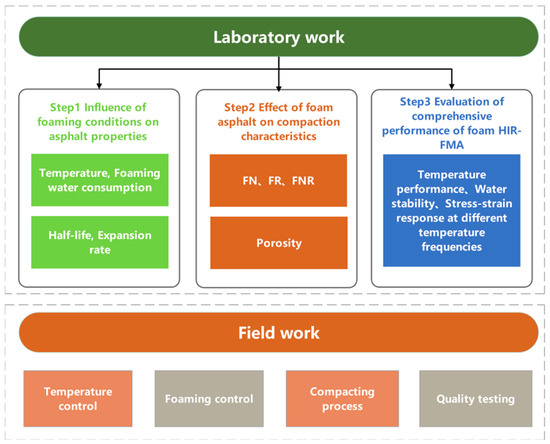
Figure 2.
Research workflow diagram used in this study.
2.4.1. The Impact of Foaming Conditions on Asphalt Performance
The WLB10 asphalt foaming machine from Wirtgen GmbH, Germany, was utilized in this experiment for indoor asphalt foaming tests. Foaming conditions were set as follows: foaming temperatures of 160 °C, 170 °C, and 180 °C and foaming water content of 1.0%, 1.5%, 2.0%, and 2.5%. A total of 12 sets of experiments were conducted, with each set performed in triplicate. The expansion rate and half life of the asphalt under different foaming conditions were measured, and the average values were taken as the final test results. The test results were then fitted and regressed in the form of y = alnx + b, and trend curves were plotted to illustrate the variations.
2.4.2. The Influence of FA on the Compaction Characteristics of Recycled Mixtures
To investigate the impact of FA on the compaction characteristics of HIR-AM, three types of HIR-FAM were prepared: (1) The asphalt in the new asphalt mixture was replaced with FA to produce the recycled mixture, referred to as FN. (2) The additional asphalt sprayed onto RAP was substituted with FA to prepare the recycled mixture, referred to as FR. (3) Both the additional asphalt added to the new asphalt mixture and the asphalt sprayed onto RAP were replaced with FA to create the recycled mixture, referred to as FNR. As a control group, we used a conventional hot-mix asphalt HIR mixture denoted as HNR. We fabricated Marshall specimens using these four types of recycled mixtures at different mixing temperatures (120 °C, 130 °C, 140 °C, 150 °C, 160 °C, and 170 °C). The compaction conditions were identical to those of conventional hot-mix modified asphalt HIR asphalt mixtures, and the percent air voids of the specimens were measured.
2.4.3. Study on the Performance of HIR-FAM
Studies have shown that the mixing temperature for HIR-AM during on-site construction is approximately 145 °C [46,47]. Therefore, in this experiment, HIR-FAM and HIR-AM were mixed and prepared at a temperature of 145 °C to investigate the influence of FA on the performance of recycled asphalt mixtures. Comparative tests were conducted following the guidelines specified in the Test Procedures (JTG E20-2011) [40].
Dynamic Stability Test
The rutting test involved the fabrication of rutting test specimens measuring 300 mm × 300 mm × 80 mm using a rolling compactor. After insulation, the specimens were placed in a rutting automatic testing machine for dynamic stability testing with a wheel pressure of 0.7 MPa. The instrument automatically recorded rut depth measurements, at 45 min () and at 60 min (), and the dynamic stability value was calculated using Equation (1).
which includes the dynamic stability of the asphalt mixture (cycles/mm); the deformation at time (mm) [48]; the deformation at time (mm); the instrument type parameter, taken as 1.0; and the specimen coefficient, taken as 1.0; and N is the reciprocal rolling speed of the test wheel, 42 cycles/min.
Low-Temperature Bending Test
The rutting test specimens, formed using the rolling compactor, are cut into small beam specimens measuring 250 mm × 30 mm × 35 mm. These specimens are placed in an environmental incubator at a test temperature of −10 °C for a constant temperature of 4 h. A modular electromechanical servo-driven asphalt testing machine (ASPHALT QU3E) is used to conduct the low-temperature bending test, from which the flexural tensile strength and maximum tensile strain were calculated.
Water Stability Test
According to Specification JTG/T 5521-2019 [45], the water stability of two types of hot recycling asphalt mixtures is evaluated using the freeze–thaw splitting test and the soaking Marshall test. For the freeze–thaw splitting test, standard Marshall specimens compacted on both sides for 50 blows were prepared. These specimens undergo a process that includes 15 min of vacuum saturation, 16 h of freezing treatment, 24 h of high-temperature treatment, and 2 h of immersion in room-temperature water. The split tensile strength of the specimens is then measured and compared with the split tensile strength of specimens immersed in room-temperature (25 °C) water for 2 h. For the soaking Marshall test, Marshall specimens of one type of mixture were divided into two groups. Both groups of specimens were simultaneously placed in a constant-temperature water bath at 60 °C. One group was soaked for 30 min, and the other group was soaked for 48 h. The Marshall stability of both groups of specimens was determined, and based on the stability values from the two groups, the soaked residual stability was calculated.
Hamburg Wheel Tracking Test
To verify the high-temperature stability and water stability of the recycled mixture, a Hamburg wheel-tracking test was conducted. This test uses asphalt mixture specimens subjected to rotary compaction, with their surfaces immersed in water at 50 ℃. Steel wheels then roll back and forth over the specimen surface for 20,000 cycles. Water stability and resistance to rutting performance were evaluated by measuring the rut depth and characteristics of the deformation curve of the asphalt mixture.
Dynamic Modulus Test
To verify the deformation resistance of the recycled mixture, dynamic modulus tests were conducted. Cylindrical specimens with dimensions of φ100 mm × 150 mm were obtained through coring from compacted asphalt samples. Dynamic modulus tests were performed using an AMPT (Asphalt Mixture Performance Tester) machine at five test temperatures (0 °C, 10 °C, 20 °C, 35 °C, and 50 °C) and six loading frequencies (25 Hz, 10 Hz, 5 Hz, 1.0 Hz, 0.5 Hz, 0.1 Hz). The dynamic modulus and phase angle of the four types of in-place hot recycling asphalt mixtures were determined through these tests.
3. Results and Discussion
3.1. Determination of Optimal Foaming Conditions
As shown in Figure 3a, the expansion ratio of SBS asphalt increases continuously with the increase in foaming water content at the same temperature, while the half life gradually decreases. This suggests that excessive water content does not improve the foaming effect of asphalt. The main reason is that with the increase in foaming water content, more water vapor is trapped by the asphalt, leading to an increase in the expansion ratio. However, as the volume of asphalt bubbles increases, the asphalt film becomes thinner, resulting in a shorter time for the internal equilibrium of the asphalt bubbles, leading to a shorter half life. Figure 3b demonstrates a good logarithmic correlation between the experimental results of the expansion ratio and the half life. Additionally, under a foaming temperature of 170 °C, the expansion ratio and half life of foamed asphalt are relatively balanced, indicating that higher temperatures do not necessarily result in a better foaming effect for SBS asphalt. This is because, while high temperatures promote the vaporization of water in asphalt to generate foam, excessively high temperatures reduce the elasticity of the asphalt film, making the asphalt bubbles unstable and prone to rupture [49]. Currently, there is no standardized limit for the acceptable values of the expansion ratio and half life. However, the relevant literature [50] suggests a lower limit standard value of 10 for the expansion ratio and 8 s for the half life. The optimal foaming water content corresponding to a foaming temperature of 170 °C was determined to be 1.7% using Equation (2) [45].
where, Wopt is the optimal foaming water content (%); W1 is the determination of the water content corresponding to the lower limit of the expansion rate standard value (%); W2 is the determination of the water content corresponding to the lower limit of the half life standard value (%). If the determined water content corresponding to the lower limit of the expansion rate standard value is below 1.5%, we take it as 1.5%. When the determined water content corresponding to the lower limit of the standard value of the half life exceeds 4.0%, it is taken as 4.0%.

Figure 3.
Foaming test results: (a) effect of different factors on the foaming properties of bitumen; (b) asphalt foaming behavior curve.
3.2. The Impact of Foamed Asphalt on Compaction Characteristics
In Figure 4, it can be observed that as the mixing temperature increases, the percentage of the air voids in the mixture gradually decreases. At the same mixing temperature, the percentage of the air voids in the HIR-FAM is smaller than that of HIR-AM. The reason for this is that foamed asphalt vaporizes water through the asphalt, causing the asphalt to foam, which increases the contact area between the asphalt and the mixture. This allows the asphalt to adhere better to the surface of the mixture, improving the smoothness of the mixture interface and thereby enhancing the compaction quality of the mixture [51]. However, the percentage of the air voids of different HIR-FAM is not constant. At 150 °C, the percentage of the air voids of FNR is 4.0%, while those of FN, FR, and HNR are 4.1%, 4.4%, and 4.5%, respectively. It can be seen that using foamed asphalt as an externally added asphalt sprayed onto RAP to prepare recycled mixtures has a relatively lower effect on improving the compaction characteristics. This may be due to the lower amount of externally added foamed asphalt compared to the other two methods, resulting in limited influence on the overall reduction in asphalt viscosity in the asphalt mixture.
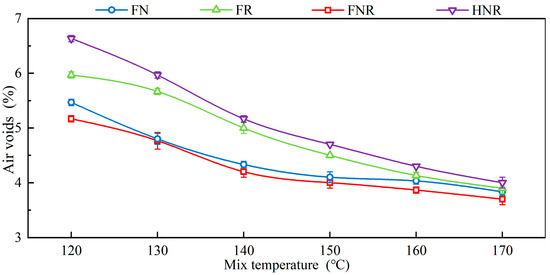
Figure 4.
Curves of mixing temperature and percentage variation in air voids.
3.3. Performance of HIR-FAM
3.3.1. Performance on the road
The high-temperature performance, low-temperature performance, and water stability of three types of HIR-FAM were determined and compared with HIR-AM. The test results are shown in Table 5.

Table 5.
Comparison of road performance test results.
From Table 5, it can be observed that the road performance of HIR-FAM is improved compared to HIR-AM at the same temperature. Furthermore, the ranking of the effect on improving the road performance of recycled mixtures is FNR > FN > FR, which aligns with the results of the compaction characteristics test of recycled asphalt mixtures. Comparing HNR and FNR at the same mixing temperature shows that FNR exhibits 11.6% higher dynamic stability, 13.4% higher bending strength, 13.3% higher maximum bending strain, 8.1% higher residual stability, and 8.5% higher freeze–thaw splitting strength ratio. These findings indicate that foam asphalt greatly enhances the temperature performance of the recycled mixture. This is attributed to the foaming technology effectively reducing the viscosity of the new asphalt, thereby improving the workability of the mixture and leading to better compaction of the recycled mixture. This results in a significant increase in the compactness of the recycled mixture. However, the improvement in water stability is relatively low. This can be attributed to the presence of residual trace water in foam asphalt, which may affect the adhesion at the aggregate–asphalt interface, allowing moisture to more easily penetrate the aggregate–foam-asphalt interface and lead to asphalt stripping. [52].
3.3.2. Hamburg Wheel Tracking
Figure 5 shows that the rut depths of FN, FR, and FNR are all less than HNR, further confirming that FA can improve the high-temperature performance and water stability of HIR-AM. However, even for FNR, the rut depth is only reduced by about 0.7 mm compared to HNR, and the differences are relatively small. The rut depth curves also exhibit some similarities. Moreover, the stripping inflection points for these four specimens are very close, requiring nearly the same number of load cycles to achieve moisture damage. This is mainly because FA accounts for a relatively small proportion of the binder material in the recycled mixtures, with the majority of the binder material coming from the asphalt in the RAP. This limitation results in a relatively modest improvement in the performance of recycled mixtures due to FA.
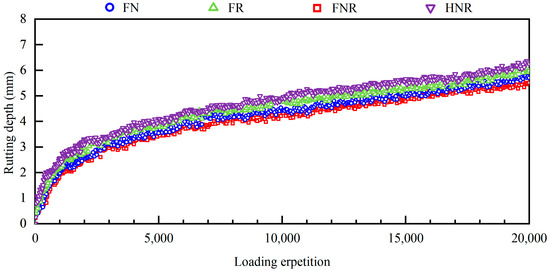
Figure 5.
Hamburg wheel tracking test results.
3.3.3. Dynamic Modulus
The deformation resistance of asphalt mixtures is primarily affected by the asphalt binder and the mineral aggregate framework. In Figure 6, it is observed that under the same test conditions, HIR-FAM exhibits slightly higher dynamic modulus values compared to HIR-AM, suggesting that HIR-FAM has superior deformation resistance. This can be attributed to the increased adhesion between foam asphalt and the aggregate [53], as well as the denser skeletal structure of HIR-FAM [54]. The dynamic modulus of recycled mixtures decreases with increasing temperature. This is because the viscosity of the asphalt binder gradually decreases at high temperatures, leading to a reduction in the dynamic modulus. An increase in loading frequency enhances the viscosity of the asphalt binder, resulting in a higher dynamic modulus for the mixture. At low temperatures, the phase angle is primarily influenced by the viscosity of the asphalt binder [55]. The high fusion degree and good adhesion between foam asphalt and aged asphalt binder contribute to the relatively high phase angle of HIR-FAM compared to HIR-AM at low temperatures. However, as the temperature increases, the influence of the mineral aggregate framework surpasses the effect of asphalt viscosity, leading to a gradual reduction in the phase angle. Due to the denser framework, HIR-FAM exhibits lower phase angles. The phase angle is higher at low temperatures and lower at high temperatures at the same frequency. This indicates that such mixtures have a stronger resistance to low-frequency loads. Foam asphalt mixtures demonstrate better resistance to low-frequency loads compared to standard hot-mix asphalt mixtures.

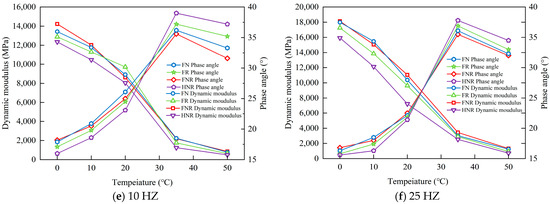
Figure 6.
Effect of different factors on the dynamic modulus and phase angle of recycled mixes.
4. Assessment of the Application Effectiveness of HIR-FAM
4.1. On-Site Construction
We selected the first maintenance project of the major and medium-sized repair project of the section from Wudi Chengkou to the S236 intersection of the S511 Dacha Line to demonstrate the effect of FA on the compaction characteristics of HIR-AM. The engineering target mix ratio follows the mix ratio in Table 4, and based on the research results, the production mix ratio is determined after adjusting the mixing effect of the pre-mixed materials at the mixing station according to the research results for the target mix ratio, and the final synthesized gradation is shown in Figure 7. HIR-FAM Type Selection FNR, with the optimal asphalt content and rejuvenator content consistent with the target mix ratio.
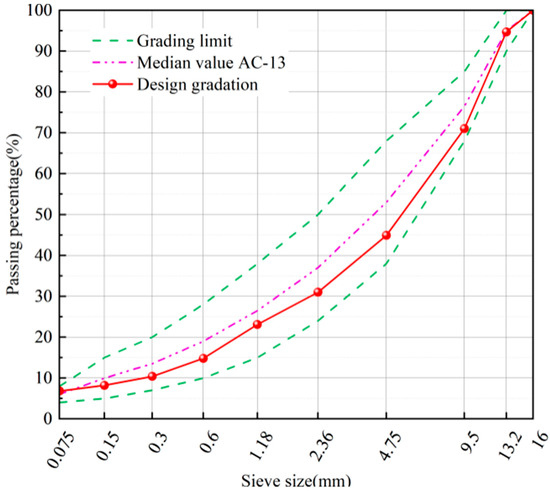
Figure 7.
Gradation curve of the production mix ratio for AC-13.
The test was conducted in June 2023 and involved six main steps. (1) The selected road segment was pre-treated for HIR, which included road closure, removal of road markings, patching damaged road surfaces, and protecting bridge expansion joints Figure 8a. (2) The existing road surface was heated using three heating machines. The surface temperatures reached 150 °C, 180 °C, and 200 °C, fully softening the road surface Figure 8b. (3) An asphalt heating and loosening machine was used to loosen the heated original road surface. During this process, a rejuvenating agent and new FA were sprayed onto the road surface along the centerline, as shown in Figure 8c. The rejuvenating agent was heated to 85 °C, and the FA was heated to 160 ℃. The measured expansion rate was 12, and the half life was 18 s. (4) A 4000-type asphalt mixing plant equipped with an asphalt foaming device was used to produce a new foam asphalt mixture. The aggregate heating temperature was set to 160 °C, the asphalt foaming temperature to 170 °C, and the foaming water content to 1.6%, considering asphalt foaming process parameters and construction conditions. The mixture was transported to the construction site by loading and unloading trucks (Figure 8d). (5) The new asphalt mixture was mixed with the reclaimed asphalt pavement (RAP) using a hot recycling machine. The hot recycling machine further heated the recycled mixture. The final temperature as it dropped into the paver’s hopper was measured at 142 °C (Figure 8e). (6) The recycled mixture was paved and compacted using a paver and three rollers. The temperature of the recycled mixture was maintained at 135 °C during paving and decreased to 85 °C by the end of compaction (Figure 8f). The before-and-after construction states are illustrated in Figure 9, indicating an improvement in the road surface condition after HIR.
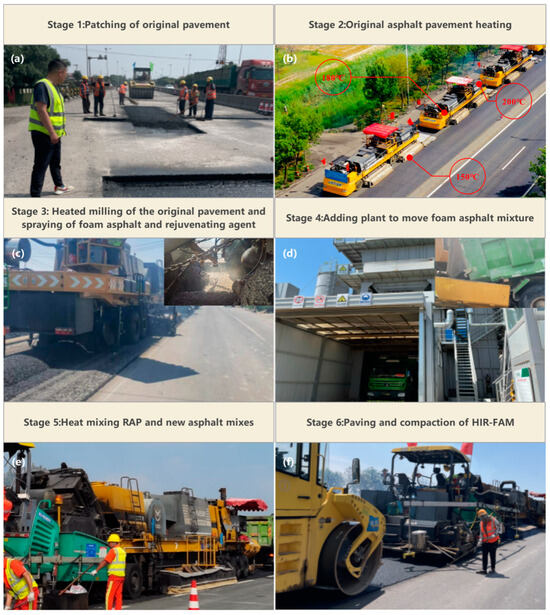
Figure 8.
Construction process flow.
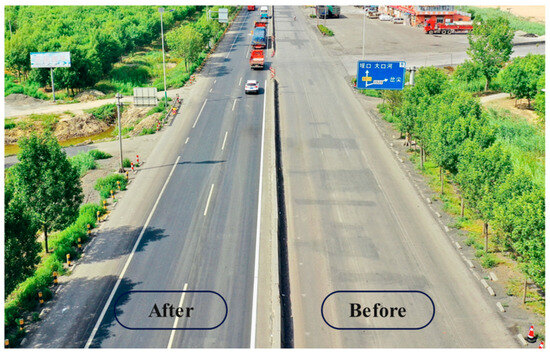
Figure 9.
The test road before and after HIR.
4.2. Quality Inspection
To verify the improvement in compaction characteristics of FA on HIR-AM, a nuclear density gauge calibrated by the core drilling method was used to measure the bulk density of the test road for HIR-FAM and the HIR-AM, as shown in Figure 10a. For the HIR-AM test road, except for the addition of ordinary modified asphalt, all other construction parameters were the same as those for the HIR-FAM. To scientifically analyze the compaction status of the on-site measurement points, a compaction degree measurement point layout plan was designed, as shown in Figure 10b. The compaction degree of the recycled pavement was calculated according to Equation (3), and the test results are shown in Figure 11. The results indicate that the compaction degree of the road section using HIR-FAM is on average 0.79% higher than that of the road section using conventional HIR-AM, and it exhibits better uniformity, which is consistent with the conclusions of the indoor test.
where is the measured density of the asphalt mixture (g/cm3) and is the maximum theoretical density of the asphalt mixture (g/cm3).
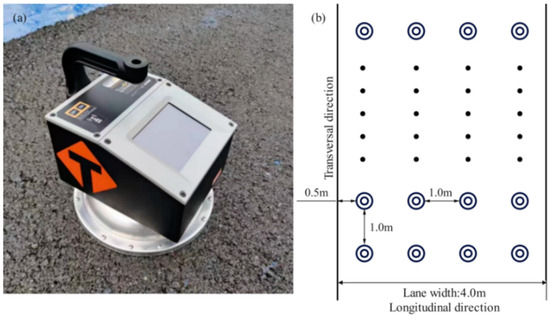
Figure 10.
The compaction degree test: (a) testing equipment; (b) layout plan for measurement points.
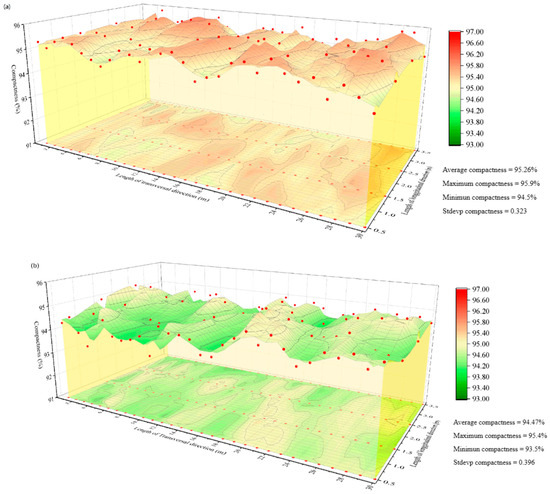
Figure 11.
Results of compaction degree for different processes: (a) HIR-FAM; (b) HIR-AM.
5. Conclusions
To enhance the compaction efficiency of HIR-AM, this paper proposes an HIR technology based on FA. Focusing on the widely used SBS asphalt, the paper systematically investigates the influence of FA on the road performance and compaction quality of HIR-AM, including the FA foaming process, the preparation process of HIR-FAM, and the road performance of the recycled mixture. The findings are validated through practical engineering applications. The main conclusions are as follows.
- (1)
- The FA foaming test indicated that parameters such as foaming temperature and water content significantly impact the foaming performance of SBS asphalt. There exists a good correlation between the expansion ratio and the half life of SBS asphalt. A foaming temperature of 170 °C achieves a relatively balanced expansion ratio and half life of the FA. Excessively high temperatures can reduce the elasticity of the asphalt film, leading to unstable asphalt foam. Additionally, at the same temperature, an increase in foaming water content results in a continuous increase in the expansion ratio and a gradual decrease in the half life, with the optimal foaming effect observed at 1.7%.
- (2)
- The test results of percentage air voids for different recycled asphalt mixtures indicate that FA can effectively reduce the percent air voids of the mixture without increasing the mixing temperature. However, the compaction effects vary for different HIR-FAMs, with FNR>FN>FR. This difference may be attributed to a higher proportion of FA in the binder material of the recycled mixture, which leads to better viscosity-reduction effects.
- (3)
- The performance testing results of recycled asphalt mixtures indicate that, at the same mixing temperature, FNR exhibits improvements in dynamic stability, flexural strength, maximum flexural strain, residual stability, and freeze–thaw splitting strength compared to HNR, with increases of 11.6%, 13.4%, 13.3%, 8.1%, and 8.5%, respectively. Additionally, it shows better resistance to water and heat stability, as well as low-frequency load resistance capabilities.
- (4)
- Based on the research conducted above, an actual on-site project for HIR was carried out. The compaction quality of the pavement was evaluated through on-site testing using a nuclear density gauge. The results indicate that the compaction degree of the pavement section using HIR-FAM is improved by 0.79% compared to the HIR-AM pavement section, and it exhibits better uniformity. This demonstrates that FA effectively enhances the compaction quality of HIR-AM.
The following limitations exist in this study at present: (1) improvement and optimization of the foaming process, including the use of external modifiers to improve the foaming properties and stability of the foamed asphalt; (2) the effect of the regeneration process on the road performance of HIR-FAM; (3) more in-depth study of the material using microscopic characterization methods.
Author Contributions
Conceptualization, X.S.; Methodology, D.G.; Visualization, J.L.; Supervision, M.X.; Formal analysis, Z.L. and Q.H.; Investigation, Q.X.; Visualization, S.Y.; Writing—original draft preparation, X.S. and M.X.; funding acquisition, D.G. and M.X.; Resources, M.X. All authors have read and agreed to the published version of the manuscript.
Funding
This study is supported by the National Key R&D Program of China (2022YFB2601900), National Natural Science Foundation of China (NO.51208287 and U2233210), the Beijing Scholars Foundation (No. 067), and the Natural Science Foundation of Shandong Province (NO. ZR2016EEM42).
Data Availability Statement
The data presented in this study are available on request from the corresponding author.
Conflicts of Interest
The authors declare no conflicts of interest.
References
- Research, G.; Institute, F. Read Carbon Neutrality: China’s Roadmap for Low-Carbon Development 2020–2050; CITIC Press: Beijing, China, 2020; p. 316. [Google Scholar]
- Liu, Z.; Sun, L.; Gu, X.; Wang, X.; Dong, Q.; Zhou, Z.; Tang, J. Characteristics, mechanisms, and environmental LCA of WMA containing sasobit: An analysis perspective combing viscosity-temperature regression and interface bonding strength. J. Clean. Prod. 2023, 391, 136255. [Google Scholar] [CrossRef]
- Liu, Z.; Yang, Q.; Gu, X. Assessment of Pavement Structural Conditions and Remaining Life Combining Accelerated Pavement Testing and Ground-Penetrating Radar. Remote Sens. 2023, 15, 4620. [Google Scholar] [CrossRef]
- Sha, A.M.; Liu, Z.Z.; Jiang, W.; Qi, L.; Hu, L.Q.; Jiao, W.X.; Barbieri, D. Advances and development trends in eco-friendly pavements. J. Road Eng. 2021, 1, 1–42. [Google Scholar] [CrossRef]
- Chen, J.Q.; Dan, H.C.; Ding, Y.J.; Gao, Y.; Guo, M.; Guo, S.; Han, B.; Hong, B.; Hou, Y.; Hu, C.; et al. New innovations in pavement materials and engineering: A review on pavement engineering research 2021. J. Trafic. Transp. Eng. 2021, 8, 815–999. [Google Scholar] [CrossRef]
- Cai, J.; Song, C.; Gong, X.B.; Zhang, J.P.; Pei, J.Z.; Chen, Z.W. Gradation of limestone-aggregate-based porous asphalt concrete under dynamic crushing test: Composition, fragmentation and stability. Constr. Build. Mater. 2022, 323, 126532. [Google Scholar] [CrossRef]
- Pasetto, M.; Baloello, A.B.; Giacomello, G.; Pasquini, E. Towards very high RAP content asphalt mixes: A comprehensive performance-based study of rejuvenated binders. J. Trafic. Transp. Eng. 2021, 8, 1022–1035. [Google Scholar] [CrossRef]
- Pan, Y.Y.; Yang, T.; Shang, Y.; Lin, M.; Liu, G.Q.; Xie, Y.C.; Zhao, Y.L. Field and laboratory evaluations of maintenance treatments for semi-rigid base asphalt pavement. Constr. Build. Mater. 2020, 258, 119726. [Google Scholar] [CrossRef]
- Yao, Y.Q.; Yang, J.G.; Gao, J.; He, L.; Xu, J. Material composition volatility and control strategy for hot in-place recycling asphalt mixture. Mater. Rep. 2022, 36, 59–68. [Google Scholar]
- Han, D.D.; Zhao, Y.L.; Pan, Y.Y.; Liu, G.Q.; Yang, T. Heating process monitoring and evaluation of hot in-place recycling of asphalt pavement using infrared thermal imaging. Automat. Constr. 2020, 111, 103005. [Google Scholar] [CrossRef]
- Ding, X.H.; Chen, L.C.; Ma, T.; Ma, H.X.; Gu, L.H.; Chen, T.; Ma, Y. Laboratory investigation of the recycled asphalt concrete with stable crumb rubber asphalt binder. Constr. Build. Mater. 2019, 203, 552–557. [Google Scholar] [CrossRef]
- Yu, B.; Wang, S.Y.; Gu, X.Y.; Ni, F.J.; Liu, Q. Environmental burden evaluation of hot in-place recycling of asphalt pavement based on discrete event simulation. Transport. Res. D-Tr. E. 2018, 65, 151–160. [Google Scholar] [CrossRef]
- Li, J.; Ni, F.J.; Jin, J.; Zhou, Z. A comparison of rejuvenator and sryrene-butadiene rubber latex used in hot in-place recycling. Road Mater. Pavement. 2017, 18, 101–115. [Google Scholar] [CrossRef]
- Yu, B.; Ni, F.J.; Zhang, L.D.; Gu, X.Y. Performance Evaluation of Aged Asphalt Mix for Hot In-Place Recycling. J. Test. Eval. 2015, 44, 770–780. [Google Scholar] [CrossRef]
- Liu, Z.; Zhou, Z.; Gu, X.; Sun, L.; Wang, C. Laboratory evaluation of the performance of reclaimed asphalt mixed with composite crumb rubber-modified asphalt: Reconciling relatively high content of RAP and virgin asphalt. Int. J. Pavement Eng. 2023, 24, 2217320. [Google Scholar] [CrossRef]
- Jiang, T.T.; Fan, Q.J.; Hou, M.Y.; Mi, S.Z.; Yan, X.H. Effects of Rejuvenator Dosage, Temperature, RAP Content and Rejuvenation Process on the Road Performance of Recycled Asphalt Mixture. Sustainability 2023, 15, 3539. [Google Scholar] [CrossRef]
- Liu, Y.; Wang, H.N.; Tighe, S.L.; Zhao, G.Y.; You, Z.P. Effects of preheating conditions on performance and workability of hot in-place recycled asphalt mixtures. Constr. Build. Mater. 2019, 226, 288–298. [Google Scholar] [CrossRef]
- Wang, T.; Jiang, W.; Xiao, J.J.; Guo, D.D.; Yuan, D.D.; Wu, W.J.; Wang, W.T. Study on the blending behavior of asphalt binder in mixing process of hot recycling. Case Stud. Const. Mat. 2022, 17, e01477. [Google Scholar] [CrossRef]
- Yang, Q.; Liu, Z.; Sun, L.; Li, Z. Analysis of the viscosity and self-healing performance of warm-mix recycled asphalt: A method combining molecular dynamics simulations and laboratory tests. Case Stud. Constr. Mat. 2023, 19, e02593. [Google Scholar] [CrossRef]
- Cheraghian, G.; Falchetto, A.C.; You, Z.P.; Chen, S.Y.; Kim, Y.S.; Westerhoff, J. Warm mix asphalt technology: An up to date review. J. Clean. Prod. 2020, 268, 122128. [Google Scholar] [CrossRef]
- Mallick, R.B.; Kandhal, P.S.; Bradbury, R.L. Using Warm-Mix Asphalt Technology to Incorporate High Percentage of Reclaimed Asphalt Pavement Material in Asphalt Mixtures. Transport. Res. Rec. 2008, 2051, 71–79. [Google Scholar] [CrossRef]
- Gkyrtis, K.; Plati, C.; Loizos, A. Structural Performance of Foamed Asphalt Base in a Full Depth Reclaimed and Sustainable Pavement. Sustainability 2023, 15, 3622. [Google Scholar] [CrossRef]
- Ali, A.; Abbas, A.; Nazzal, M.; Alhasan, A.; Roy, A.; Powers, D. Effect of temperature reduction, foaming water content, and aggregate moisture content on performance of foamed warm mix asphalt. Constr. Build. Mater. 2013, 48, 1058–1066. [Google Scholar] [CrossRef]
- Dong, F.Q.; Yu, X.; Wang, T.Y.; Yin, L.; Li, J.; Si, J.J.; Li, J. Influence of base asphalt aging levels on the foaming characteristics and rheological properties of foamed asphalt. Constr. Build. Mater. 2018, 177, 43–50. [Google Scholar] [CrossRef]
- Hu, J.Y.; Ma, T.; Yin, T.; Zhou, Y. Foamed warm mix asphalt mixture containing crumb rubber: Foaming optimization and performance evaluation. J. Clean. Prod. 2022, 333, 130085. [Google Scholar] [CrossRef]
- Alhasan, A.A.; Abbas, R.A.; Nazzal, M. Low-Temperature Characterization of Foamed Warm-Mix Asphalt Produced by Water Injection. Transp. Res. Rec. 2014, 2445, 1–11. [Google Scholar] [CrossRef]
- Xu, S.Y.; Xiao, F.P.; Amirkhanian, S.; Singh, D. Moisture characteristics of mixtures with warm mix asphalt technologies-A review. Constr. Build. Mater. 2017, 142, 148–161. [Google Scholar] [CrossRef]
- Monu, K.; Singh, S. Effect of long-term ageing on properties of RAP inclusive WMA mixes. Constr. Build. Mater. 2019, 206, 483–493. [Google Scholar] [CrossRef]
- Tang, Y.C.; Wang, Y.F.; Wu, D.X. Exploring temperature-resilient recycled aggregate concrete with waste rubber: An experimental and multi-objective optimization analysis. Rev. Adv. Mater. Sci. 2023, 62, 20230347. [Google Scholar] [CrossRef]
- Guo, M.; Liu, H.P.; Jiao, Y.B. Effect of WMA-RAP technology on pavement performance of asphalt mixture: A state-of-the-art review. J. Clean. Prod. 2020, 266, 121704. [Google Scholar] [CrossRef]
- Rondón-Quintana, H.A.; Fernández-Gómez, W.; Zafra-Mejía, C.A. Behavior of a warm mix asphalt using a chemical additive to foam the asphalt binder. Rev. Fac. Ing. Univ. Antioq. 2016, 78, 129–138. [Google Scholar] [CrossRef]
- Zheng, Z.G.; He, Y.W.; Wang, T. Study on the Performance of the Physical Foaming Warm-mix Recycled Asphalt Mixture. E3S Web Conf. 2021, 261, 02058. [Google Scholar] [CrossRef]
- Abreu, L.P.F.; Oliveira, J.R.M.; Silva, H.M.R.D.; Palha, D.; Fonsece, P.V. Suitability of different foamed bitumens for warm mix asphalts with increasing recycling rates. Constr. Build. Mater. 2017, 142, 342–353. [Google Scholar] [CrossRef]
- Zhao, S.; Huang, B.S.; Shu, X.; Jia, X.Y.; Woods, M.B. Laboratory Performance Evaluation of Warm-Mix Asphalt Containing High Percentages of Reclaimed Asphalt Pavement. Transp. Res. Rec. 2012, 2294, 98–105. [Google Scholar] [CrossRef]
- Ashiqur, R.M.; Rouzbeh, G.; Musharraf, Z. Rutting and moisture-induced damage potential of foamed warm mix asphalt (WMA) containing RAP. Innov. Infrastruct. So. 2021, 6, 158. [Google Scholar] [CrossRef]
- Kavussi, A.; Hashemian, L. Laboratory evaluation of moisture damage and rutting potential of WMA foam mixes. Int. J. Pavement Eng. 2012, 13, 415–423. [Google Scholar] [CrossRef]
- Jeong, M.M.; Kim, S.G.; Shen, J.N. Laboratory evaluation of foamed asphalt mixtures with 100% RAP and rejuvenator. Aust. J. Civ. Eng. 2020, 19, 46–57. [Google Scholar] [CrossRef]
- Transport, M.O. Highway Performance Assessment Standards; China Communications Press: Beijing, China, 2018. [Google Scholar]
- Wang, D.; Liu, Z.; Gu, X.; Wu, W. Feature extraction and segmentation of pavement distress using an improved hybrid task cascade network. Int. J. Pavement Eng. 2023, 24, 2266098. [Google Scholar] [CrossRef]
- Transport, M.O. Standard Test Methods of Bitumen and Bituminous Mixtures for Highway Engineering; China Communications Press: Beijing, China, 2011. [Google Scholar]
- Transport, M.O. Technical Specifications for Construction of Highway Asphalt Pavements; China Communications Press: Beijing, China, 2004. [Google Scholar]
- Liu, Z.; Gu, X.; Ren, H. Rutting prediction of asphalt pavement with semi-rigid base: Numerical modeling on laboratory to accelerated pavement testing. Constr. Build. Mater. 2023, 375, 130903. [Google Scholar] [CrossRef]
- Liu, Z.; Gu, X.; Dong, Q. Permanent Deformation Evaluation and Instability Prediction of Semi-rigid Pavement Structure Using Accelerated Pavement Testing and Finite Element Method. J. Test Eval. 2023, 52. [Google Scholar] [CrossRef]
- Liu, Z.; Gu, X.; Dong, X.; Cui, B.; Hu, D. Mechanism and Performance of Graphene Modified Asphalt: An Experimental Approach Combined with Molecular Dynamic Simulations. Case Stud. Constr. Mat. 2022, 18, e01749. [Google Scholar] [CrossRef]
- Transport, M.O. Technical Specification for Highway Asphalt Pavement Recycling; China Communications Press: Beijing, China, 2019. [Google Scholar]
- Zhong, H.B.; Huang, W.D.; Yan, C.Q.; Zhang, Y.; Lv, Q.; Sun, L.J.; Liu, L.Y. Investigating binder aging during hot in-place recycling (HIR) of asphalt pavement. Constr. Build. Mater. 2021, 276, 122188. [Google Scholar] [CrossRef]
- Tang, X.N. Study on Construction Quality Evaluation in Hot In-Place Recycling of Asphalt Pavement. Master’s Thesis, Southeast University, Nanjing, China, 2020. [Google Scholar]
- Liu, Z.; Gu, X.; Ren, H.; Li, S.; Dong, Q. Permanent Deformation Monitoring and Remaining Life Prediction of Asphalt Pavement Combining Full-Scale Accelerated Pavement Testing and FEM. Struct. Control. Health Monit. 2023, 2023, 6932621. [Google Scholar] [CrossRef]
- Li, Y.S. Study on Application Performance of Foamed Asphalt in Seasonal Freezing Environment. Master’s Thesis, Jilin University, Changchun, China, 2019. [Google Scholar]
- He, Y.Z.; Wang, Q.G.; Zhang, J.P.; Li, Y.; He, H.Q.; Huang, G.J. Foamed crumb rubber asphalt binder: Preparation, rheological properties and adhesion characteristics. J. Clean. Prod. 2023, 396, 136516. [Google Scholar] [CrossRef]
- Ali, A.; Abbas, A.; Nazzal, M.; Alhasan, A.; Roy, A.; Powers, D. Workability Evaluation of Foamed Warm-Mix Asphalt. J. Mater. Civil Eng. 2013, 26, 04014011. [Google Scholar] [CrossRef]
- Zhao, H.; Ren, J.D.; Chen, Z.; Luan, H.; Yi, J.Y. Freeze and thaw field investigation of foamed asphalt cold recycling mixture in cold region. Case Stud. Const. Mat. 2021, 15, e00710. [Google Scholar] [CrossRef]
- Wang, J.; Zheng, K.P.; Xu, J.; Liu, C.P. Influence of foaming water content on mechanical properties of foamed warm asphalt mixture. J. Highw. Transp. Res. Deve. 2023, 40, 1–8. [Google Scholar]
- Meng, A.X.; Xu, H.N.; Fu, X.G.; Tan, Y.Q. Dynamic moduls and prediction model of asphalt mixture based on structural natural frequency. China J. Highw. Transp. 2019, 32, 31–38. [Google Scholar]
- Ruan, L.; Luo, R.; Hu, X.D.; Pan, P. Effect of bell-shaped loading and haversine loading on the dynamic modulus and resilient modulus of asphalt mixtures. Constr. Build. Mater. 2018, 161, 124–131. [Google Scholar] [CrossRef]
Disclaimer/Publisher’s Note: The statements, opinions and data contained in all publications are solely those of the individual author(s) and contributor(s) and not of MDPI and/or the editor(s). MDPI and/or the editor(s) disclaim responsibility for any injury to people or property resulting from any ideas, methods, instructions or products referred to in the content. |
© 2023 by the authors. Licensee MDPI, Basel, Switzerland. This article is an open access article distributed under the terms and conditions of the Creative Commons Attribution (CC BY) license (https://creativecommons.org/licenses/by/4.0/).